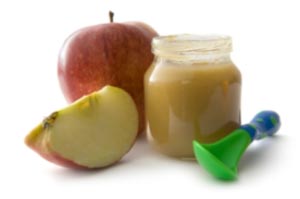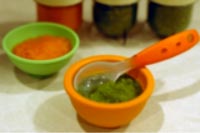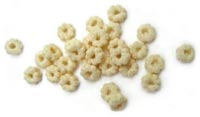Featured Video
Starting Solid Foods
 We recommend introducing solid foods between the ages of 4 and 6 months.
We recommend introducing solid foods between the ages of 4 and 6 months.
Readiness
Physical clues to indicate that your child is ready for solids:
- Ability to hold his/her head up well and sit with support.
- Interest in food: he/she is reaching or grasping for your food.
- Beginning to lose tongue thrust reflex and able to use to tongue to move food from the front to the back of his mouth.
Solids as Part of the Diet
- At first, food is mostly fun and does not provide much nutritional value for your infant. Nutrition will still be primary from breast milk or formula.
- Nursing sessions and/or bottles will likely remain the same in quantity until around 9 months of age when solids begin to take over more of the nutritional value.
What Foods do I Start With?
- Pediatricians used to recommend introducing food in a step-wise fashion and delaying introduction of certain high allergy foods. The most recent data now supports introducing all types of solids in the order that feels most comfortable to parents.
- Many parents start with iron-fortified rice or oatmeal cereal, but you should not feel that this needs to be your starter food.
- We recommend starting with pureed yellow/orange vegetables (sweet potato/squash/carrots) as well as iron fortified cereals in the first few weeks.
- You may mix the cereal with some formula or breast milk. You may also mix a tablespoon of cereal into pureed vegetables or fruit.
- Fruits such as apple, pear, banana, plum, nectarine or blueberries are excellent fruit starters.
- Good starter vegetables are avocado, peas and green beans.
How to Start
- Choose a time that your infant is not very sleepy or very hungry—often one hour after a bottle or nursing session is a good time.
- Start with one new food every 3-4 days, watching for any reactions such as a rash, diarrhea, vomiting or wheezing.
- Try new foods in the morning or early afternoon and avoid them in the evening when it is more difficult to monitor reactions.
- Make eating a fun and social event! If you can, eat together with your baby and bring the seat up to the table where the family eats.
- Infant should be in a high chair or seated at an angle to avoid a choking risk.
- Spoon feed your infant or allow them to grab the puree and explore the food on their own — both are valuable, but messy techniques! As they get better, you can make your foods thicker and less runny.
- Feed your infant until they give you the cue they are done—shaking their head or pushing the food away.
- Watch your baby’s impressions of new foods—remember to keep trying a new food at least 10-15 times before you think they don’t like it!
 Advancing Your Rainbow of Foods: 5/6/7 Months
Advancing Your Rainbow of Foods: 5/6/7 Months
- Fairly quickly you and your baby will want to move past fruits and vegetables and you can! There is no set order to food introduction, but generally parents feel comfortable expanding their infant diet once they are getting the hang of feeding and are around 5/6 months.
- Feel free to introduce:
- Legumes—lentils, beans
- Pureed meats—such as chicken, beef, lamb. Get creative if you like and make meat stews with chicken broth, apples, and sweet potatoes to provide new combinations.
- Fish and tofu
- Full fat yogurt—either plain or mixed with pureed fruit. Thicker yogurts, such as Greek style stay on the spoon and make feeds easier.
- You can also use grated cheese in your purees, such as parmesan.
- You may use spices in your foods as well but we do recommend avoiding adding sugar or salt to your baby’s foods at this stage.
 Moving Past Purees: 8/9 months
Moving Past Purees: 8/9 months
- Infant should be eating 3 solid meals a day by now with each feed ranging between a few tablespoons up to ½ a cup.
- At this age infants can typically reach for small items and pick them up between their fingers or between their fingers and palms. This means they are ready for cut up pieces of food!
- Try pieces of whole eggs, bread, baked goods, soft cooked vegetables and fruits in pieces, very finely cut or ground meat, flaked fish, mashed legumes.
- Be aware of items that may be choking hazards (grapes for example).
- As your baby gets older they will be able to eat more foods from your plate such as pasta with meat sauce, meat balls, quinoa, rice with mashed beans, cheese, pieces of vegetables and fruit in bite size pieces, shellfish, nut butters, and much more.
Foods to Avoid:
- This list has gotten significantly smaller over the last decade as research has shown no decrease in food allergies by delaying introduction of allergenic foods.
- Under one, your child should avoid drinking cow’s milk to protect his/her kidneys and avoid eating raw honey to prevent infection with botulism.
- After age 1 year, it is safe to add milk and honey into the diet.
- Avoid choking hazards such as whole peanuts, whole grapes, popcorn, uncooked hard vegetables.
Food Allergies:
The most recent studies are suggesting that introduction of more allergenic foods such as eggs, tree nuts, peanuts, and shellfish earlier rather than later has protective effects. Delaying these foods past the 9 month mark is likely not protective against future allergies. Talk with your doctor about specific questions or food concerns.
